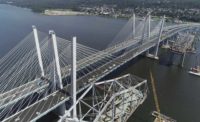Worker safety concerns sparked a new plan on how to demolish the remnants of the old Tappan Zee Bridge in New York.
Contractors earlier in the fall submitted a plan to use explosives to take down a section of the old span, Federal Highway Administration Spokesman Doug Hecox told ENR on Dec. 7. That’s in contrast to the procedure that had been in place: dismantling and removing the bridge piece by piece.
It is unclear what type of explosives will be used or how workers will place them on the old bridge's east span while staying safe.
“The east span is tilting and is structurally unsound,” Hecox said. “So workers can’t get on it — it’s unsafe for them.”
Earlier, on Sept. 8, just days before the nearly $4-billion replacement Tappan Zee was to open, prime contractor Tappan Zee Constructors announced a flaw in one of the original bridge’s joints. That meant the old structure could fall — although it would be “within a safety zone that does not affect vessel traffic or the structural integrity of the new eastbound bridge,” TZC President Terry Towle said in a statement at the time.
The new demolition plan was initially reported by the Wall Street Journal.
The new bridge, named the Mario M. Cuomo Bridge by New York Gov. Andrew Cuomo, opened to traffic on Oct. 6, 2018.
The demolition plan is complex and still being fine-tuned, Hecox said, so it’s unclear what type of explosives will be used or how workers will place them on the old bridge's remaining superstructure while staying safe.
Officials will also need to speak with the National Marines Fishery Service and Riverkeeper, an advocacy group, about adverse environmental impacts, Hecox said.
Work at the river crossing, about 20 miles north of New York City, poses a possible threat to endangered sturgeon species, which the project team has avoided harming.
In 2013, the spokesman at the time for the bridge's owner, The New York Thruway Authority, told ENR that "we're only allowed to dredge from August 1 to November 1 to protect … the Atlantic and short-nosed sturgeon. That window avoids their main spawning and migration season."
Crews have already removed major portions of the old bridge. A 603-ft-long central section, the largest, was removed with strand jacks and barges.
The New York Thruway Authority project executive, Jamey Barbas, noted in August that the demolition was her biggest safety concern, particularly removing concrete caissons as deep as 60 ft. She told ENR at the time: “Crews will have to ‘collapse’ the caissons and get all the debris out. It will be the most challenging part of the job safety-wise.”
Thousands of Tons of Concrete and Steel
The demolition includes 302,200 tons of concrete, 46,790 tons of steel, 13,192 timber foundation piles, 2,000 precast deck panels, 196 piers, 30 circular caissons, 20 steel truss sections and eight rectangular caissons.
A Thruway Authority spokesperson referred questions to Tappan Zee Constructors, which is responsible for the old bridge.
“In the interest of the safety of our workers and the traveling public, Tappan Zee Constructors is reviewing alternative means and methods to remove the old Tappan Zee Bridge’s east anchor span,” spokeswoman Laura Ware said Friday. “TZC is working with local, state, and federal agencies and various experts to determine the safest way to lower the span. At this time, the east anchor span conditions remain unchanged from Tappan Zee Constructors’ previous assessment.”




Post a comment to this article
Report Abusive Comment